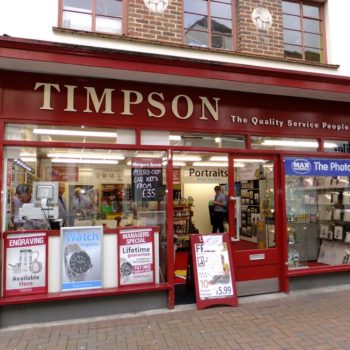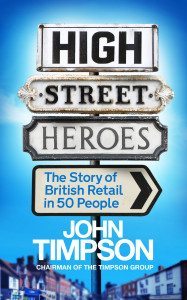High street heroes

A new book by John Timpson CBE, of iconic retail group Timpson, looks at the history of retailing through 50 of its most influential figures. Doug Whelan caught up with the author and businessman to hear his thoughts on the industry’s past, present and future
17 December 2015

When writing High Street Heroes: The Story of British Retail in 50 People, John Timpson says ranking retailers in order of importance was “the hardest challenge
Recently in the pages of ShelfLife, we have heard from experts on the present and future of the retail industry. Experts like Doug Stephens (November issue) and Professor Brian Wannsink (October issue) outlined their theories on the current state of things, and how new ideas and approaches, either in technology or culture or somewhere in between, can and will affect businesses and the industry as a whole. But with all that in mind, when it comes to making a business work, there is no substitute for hard graft being put in by someone who cares passionately about their product and also about their customers.
Few people in the industry know this better than John Timpson CBE, owner of the historic (not to mention vast) Timpson chain. As owner of the company with more than 1,300 outlets across the UK and Ireland, Timpson runs his business by delegating a large amount of autonomy to the individual owners of the outlets; he says that this is because it’s best to trust the people who serve their own customers to do it their own way. “Not many other companies do it that way,” he tells ShelfLife. “Most people would expect you to run a company by head office making policy and ensuring everybody else follows it. “That’s not my cup of tea at all,” he says.
So then, having run the family business since the 1960s (it was originally established in 1865 by his great-grandfather William Timpson), John Timpson is a man who knows a thing or two about running large retail companies, as well as the importance of decision-making at all levels. This knowledge and understanding makes him the perfect author for High Street Heroes: The Story of British Retail in 50 People.
Journey through history
In the book, Timpson outlines how successive generations of forward-thinking shopkeepers and inspirational entrepreneurs have led the major retailers through rapid change. Some (including the likes of Doug Stephens) say that retail is going through a period of change right now; Timpson disagrees, suggesting that the current changes are just tremors that have been ongoing for 50 years.
The finished product is a journey through history, anchored through the achievements of generations of retail icons. But Timpson explains that his original idea for the book was a simple rundown of “the 50 greatest retailers”, although he soon realised that would be difficult to achieve without offering some context of each of the specific areas his choices occupied.
“I eventually realised I had to step back and look at the whole history of retailing over 50 or more years,” he says, “not just the people. You can’t divorce the two. The book turned into a journey through the whole retail world.
“I can’t recall which individual I began with,” he continues. “I think perhaps it was one of the supermarket people…Jack Cohen [founder of Tesco] maybe. Anyway, I realised it would be difficult to talk about him without going in to some of the history and culture of supermarkets, how they all started and so on, and it went from there.
“I must say, I learned an awful lot myself doing it that way,” Timpson says. “I stepped back through time a little each time, then forward, then back.
“It was rather like peeling an orange,” he quips. “Or an onion, perhaps!”
Tremors
Through this process, we wonder what Timpson identified or learned about the industry. In it, he claims that retail is always undergoing change, as opposed to just recently, as some suggest. “You hear it said that the high street has never experienced the change it’s experiencing at the moment,” Timpson says measuredly. “The internet, for example, has changed everything. My response to that is that recent developments aren’t what are changing it – the changes have been taking place for a long, long time before now.
“In other words, the internet is just another tremor; they have been coming for decades now.”
When he puts it like that, we can see his point. The internet is the latest thing to come along and ‘disrupt’ retail; there have been many other disruptions prior to that, either technological, political, social or otherwise. Timpson notes one of the earliest examples as ‘retail price maintenance’ – or the relaxation of it in the 1960s, to be precise.
“Before 1963 or 1964,” Timpson explains, “prices were set by the manufacturer. If you were selling a can of beans, you sold it for the price you were instructed, and that couldn’t be changed.
“Once that restriction disappeared, it opened the way for discount retailing; in particular it paved the way for supermarkets to take over from local shops, which eventually moved shopping out of towns.”
Another of Timpson’s tremors is, interestingly, the introduction of equal pay for men and women. “Up until then, women were paid considerably less than men,” he says, “and that’s just the way things were.
“That was a big change, because it added to inflation. Everybody was being paid up to £6 a week; some workers had their wages increase by 50%. That meant that shops couldn’t afford to pay as many staff. So that led to a lot more self-service in stores.”
This change again played into the hands of supermarkets and over time the retail landscape altered. Another tremor was felt.
Timpson’s book is brimming with such anecdotes about the industry even before one begins to consider the individual figures that were the inspiration for it in the first place. “When and where shopping was done changed drastically after World War II,” he says, “because so many towns and villages had to be rebuilt following the Blitz. Changes to tax systems over the years would have had an effect on prices, when purchase tax evolved into VAT. Sunday shopping laws made a huge difference too.”
All of these things were relatively small changes at the time, but the ramifications in the subsequent years changed the landscape of retailing greatly, when you line them up and consider how they tie in to one another.
Who’s who?
So then, with all this historical context in mind, Timpson then had the task of not only identifying the 50 most influential retailers, but also ranking them in order of importance. Is such a thing possible? Can one really compare an ‘old-school’ retailer like Jack Cohen to a 21st century tycoon like Philip Green?
“Putting them in order was the hardest challenge,” Timpson admits. “My number one had to be the person I believe to be the most significant, and that has to be Marcus Sieff of Marks & Spencer. He created a business which in terms of how much better it was than its peers, in its day, has never been matched.
“That’s not to say that M&S are in that position today,” he adds.
In the book, Timpson also looks at Simon Wolfson, who is the current chief executive of Next. Wolfson became the youngest CEO of a publicly-traded company, at 33 years old, when he was appointed to the role in 2001. He has made headlines in the past for waiving his multi-million pound bonuses, instead ordering them to be distributed among Next staff. In 2014 this bonus amounted to £3.8m, in 2013 it was £2.4m.
“In the coffee bar area,” Timpson continues, “you have Julian Metcalf at Pret-a-Manger. I have different people on the list for different reasons, but Marcus is certainly the number one name on the list.”
Other names in the book include Ken Morrison, former chairman of Morrison’s, which Timpson allows is not what people would see as a top supermarket today. “He was a superstar at developing a business from scratch,” Timpson says. “However, nobody has been able to carry on his culture because he is very much his own man.”
Then there’s Philip Green, owner of several major retail brands including Miss Selfridge, Topshop, Topman, Dorothy Perkins and more. “He’s certainly on the list,” says Timpson, who recalls in the book a series of prickly encounters with the billionaire businessman, “but not that high. His business is enormously significant in the fashion area, but less so than Next or John Lewis. Philip is not a creator of new ideas; he’s a buyer of businesses. If this was a list of dealmakers, he would be very high on that.”
All in all, the people who make John Timpson’s list of 50 High Street Heroes, are the ones who had the entrepreneurial skills to make their business work, but who also were (or are) true leaders who got the respect of their people and who were in it for the long term. “Something they all have in common,” he says “is a combination of flair and leadership.”
High Street Heroes: The Story of British Retail in 50 People by John Timpson is available now in paperback and eBook.



 Print
Print





Fans 0
Followers